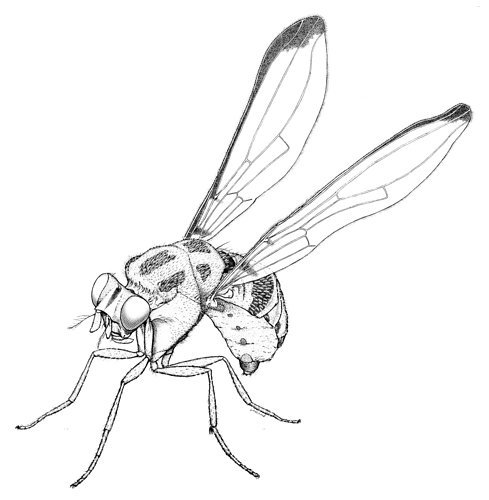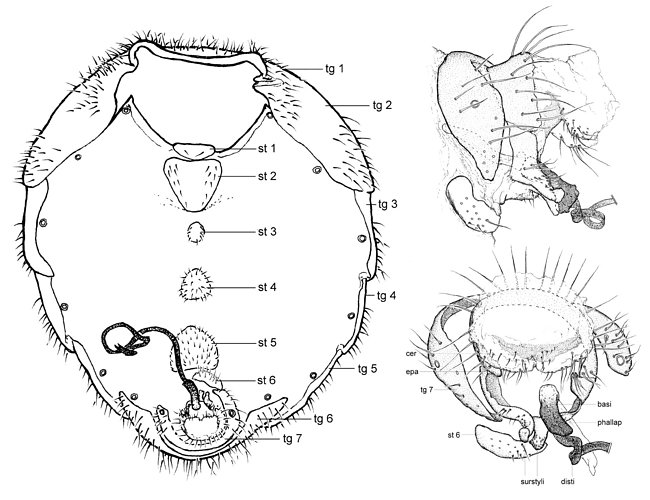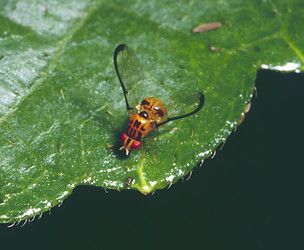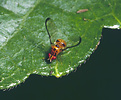Somatiidae
Somatia
Owen Lonsdale- Somatia aestiva
- Somatia australis
- Somatia carrerai
- Somatia lanei
- Somatia papaveroi
- Somatia schildi
- Somatia sophiston
Introduction
The Somatiidae is a family of seven similar species within the single genus Somatia Schiner. Somatia is endemic to the Neotropical Region, with species found from Bolivia and Venezuela to Guatemala (Steyskal 1970). The most commonly collected species is the widespread S. aestiva (Fabricius). The species were keyed and catalogued by Steyskal (1968, 1970), and the family was last treated by Lonsdale&McAlpine (2010) in the Manual of Central American Diptera.Immature stages and biology are unknown, however, one adult was observed (by S.A. Marshall in Bolivia) feeding on a dead caterpillar.
Characteristics
Somatiids are characteristic black and yellow flies 3.5-5.0 mm in length. The thorax is stout and broadly rounded with a distinct transverse suture. The legs are widely separated from the abdomen by an elongate postcoxal bridge. The scutellum is bulbous and broadly rounded with the anterior corners strongly tapered, and the surface is clothed with fine, erect setulae. The abdomen, which is held downwards, is very broad and dome-like, with tergites 1-6 covering the remaining segments. There is a strong ridge between tergites 1 and 2 and the sternites are very reduced.


Figure: Somatia aestiva (F.), habitus. © Owen Lonsdale.
Thoracic chaetotaxy is reduced and fine; there are two posterior notopleurals, one dorsocentral, one prescutellar acrostichal, one intra post-alar, one anepisternal, and two or three pairs of scutellar bristles. There are no bristles on the legs excluding two or three ventroapical bristles on the mid tibia.
The wing is narrowed basally, not having a distinct alula or anal lobe. Cells bm and cup are long and enclosed, veins R2+3 and M1 are converging on R4+5 apically, the terminal section of CuA1 is short to absent, and the subcostal break is distinct. The wing is heavily infuscated along the anterior margin with two variably developed basal longitudinal stripes.
The head is held away from the thorax by a pronotum that is dorsally depressed and 'neck-like'. The frons is sharply produced anteriorly, extending over the scape. The pedicel is slit dorsally, the first flagellomere elongate and setulose, and the arista is long bipectinate. The frontal plate is shiny (similar to some chloropids) and widening anteriorly, and the fronto-orbital plate is setulose and without bristles. Small convergent postocellar and inner vertical bristles are present. The vibrissae are short and slender.
Externally, Somatiidae are most likely to be mistaken for Syringogastridae, which also have an enlarged pronotum, a postcoxal bridge, a strongly narrowed wing and reduced chaetotaxy. Syringogastrids however, can be distinguished by having a petiolate abdomen, an enlarged and armed hind femur, an absence of the vibrissae and postvertical bristles, and a relatively spherical head.
Somatiid male genitalia are characteristic in that the components are highly reduced (only the distiphallus, basiphallus, phallapodeme and ejaculatory apodeme remain of the hypandrial complex), excluding the distiphallus, which is extremely long, heavily sclerotized, and exposed beneath the abdomen. The epandrium and surstyli are thin, fused and ring-like.


Figure: Somatia aestiva (Fabricius) male; abdomen, ventral; genitalia, left lateral; genitalia, ventral. © Owen Lonsdale.
The most prominent component of the female genitalia is the stout annular tergosternite 7. The cerci are small, truncated and setose. There are two dark cylindrical spermathecae covered with minute papillae.
Relationships of Somatia to Other Acalyptrate Flies
The Somatiidae has been associated with the Periscelididiae, Richardiidae, and Heleomyzidae at different times (Griffiths 1972), but there is no support for these groupings (McAlpine 1997). J.F. McApline (1989), whose classification we use, placed Somatia in the Diopsoidea as the sister-group to the Psilidae on the basis of a dorsal seam on the pedicel, an abbreviated subcostal vein, an enlarged subcostal break, and two spermathecae. D.K. McAlpine (1997) most recently discussed the Somatiidae, where he maintained it as an unplaced genus within the Acalyptratae.
References
Griffiths G.C.D. 1972. The Phylogenetic Classification of Diptera Cyclorrhapha with Reference to the Structure of the Male Postabdomen. Dr. W. Junk N.V., Publishers, The Hague.
Lonsdale, O. & McAlpine, D.K. 2010. 59: Somatiidae. Pp. 833-835, In: Brown, B. et al. (Eds.) "Manual of Central American Diptera, Volume 2". NRC Research Press, Ottawa.
McAlpine, D.K. 1997. Gobryidae, a new family of acalyptrate flies (Diptera: Diospsoidea), and a discussion of relationships of the diopsoid families. Records of the Australian Museum 49: 167-194.
McAlpine, J.F. 1989. Phylogeny and classification of the Muscomorpha. In J.F. McAlpine (ed.).Manual of the Nearctic Diptera. Vol. 3. Research Branch, Agriculture Canada. Monograph No. 32. Ottawa.
Steyskal, G.C., 1968. The genus Somatia Schiner, II. (Diptera: Somatiidae). Proceedings of the Entomological Society of Washington 70: 255-257.
Steyskal, G.C. 1970. Family Somatiidae. A Catalogue of the Diptera of the Americas south of the United States 94: 2 pp.
Title Illustrations

| Scientific Name | Somatia aestiva (F.) |
|---|---|
| Location | Bolivia |
| Specimen Condition | Live Specimen |
| Life Cycle Stage | Adult |
| Copyright |
© Steve Marshall

|
| Scientific Name | Somatia aestiva (F.) |
|---|---|
| Location | Bolivia |
| Specimen Condition | Live Specimen |
| Life Cycle Stage | Adult |
| Copyright |
© Steve Marshall

|
About This Page
Owen Lonsdale

Canadian National Collection of Insects, Arachnids & Nematodes
Correspondence regarding this page should be directed to Owen Lonsdale at
Neoxabea@hotmail.com
Page copyright © 2011 Owen Lonsdale
 Page: Tree of Life
Somatiidae. Somatia.
Authored by
Owen Lonsdale.
The TEXT of this page is licensed under the
Creative Commons Attribution-NonCommercial License - Version 3.0. Note that images and other media
featured on this page are each governed by their own license, and they may or may not be available
for reuse. Click on an image or a media link to access the media data window, which provides the
relevant licensing information. For the general terms and conditions of ToL material reuse and
redistribution, please see the Tree of Life Copyright
Policies.
Page: Tree of Life
Somatiidae. Somatia.
Authored by
Owen Lonsdale.
The TEXT of this page is licensed under the
Creative Commons Attribution-NonCommercial License - Version 3.0. Note that images and other media
featured on this page are each governed by their own license, and they may or may not be available
for reuse. Click on an image or a media link to access the media data window, which provides the
relevant licensing information. For the general terms and conditions of ToL material reuse and
redistribution, please see the Tree of Life Copyright
Policies.
- First online 04 August 2005
- Content changed 06 January 2011
Citing this page:
Lonsdale, Owen. 2011. Somatiidae. Somatia. Version 06 January 2011 (under construction). http://tolweb.org/Somatia/10596/2011.01.06 in The Tree of Life Web Project, http://tolweb.org/










 Go to quick links
Go to quick search
Go to navigation for this section of the ToL site
Go to detailed links for the ToL site
Go to quick links
Go to quick search
Go to navigation for this section of the ToL site
Go to detailed links for the ToL site